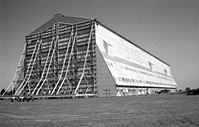Cardington, Bedfordshire
| Cardington | |
| Bedfordshire | |
|---|---|
 Chapel End, Cardington | |
| Location | |
| Grid reference: | TL085475 |
| Location: | 52°6’58"N, 0°24’50"W |
| Data | |
| Population: | 317 (2001) |
| Post town: | Bedford |
| Postcode: | MK44 |
| Dialling code: | 01234 |
| Local Government | |
| Council: | Bedford |
| Parliamentary constituency: |
North East Bedfordshire |
Cardington is a village in the midst of Bedfordshire, in the Wixamtree Hundred.
The village is best known for its connection with the great days of the airships: the Cardington Airship Works were founded here by Short Brothers during the First World War, and the huge airship sheds are a dominant feature. The site later became an RAF training station (albeit that most of the former RAF station is actually in the parish of Eastcotts, as is the village of Shortstown, built by Short Brothers for its workers.[1]) Shortstown and the RAF station lie southwest of Cardington itself.
Contents
Parish church
The Church of St Mary the Virgin has pieces dating from the 12th century, although the church itself was mostly rebuilt between 1898 and 1902. It still has five Norman gargoyles on the exterior.
St Mary's contains the Whitbread Chapel and a memorial plaque to the R101 airship, and artefacts from the disaster.
Airships, barrage balloons and RAF Cardington
Cardington became one of the major British sites involved in the development of airships when Short Brothers bought land there to build airships for the Admiralty. They constructed a 700-foot-long airship hangar (the No. 1 Shed) in 1915 to enable them to build two rigid airships, the R-31 and the R-32. Some 800 people worked there in 1917, most of them travelled daily from Bedford. Shorts also built a housing estate, opposite the site to house its workers, which they named Shortstown.
The airships site was nationalised in April 1919, becoming known as the Royal Airship Works.
In preparation for the R101 project the No 1 shed was extended between October 1924 and March 1926; its roof was raised by 35 feet and its length increased to 812 feet. The No. 2 shed (Southern shed), which had originally been located at RNAS Pulham in Norfolk, was dismantled in 1928 and re-erected at Cardington.
After the crash of the R101, in October 1930, all work on airships stopped in Britain. Cardington then became a storage station.
In 1936/1937 Cardington started building barrage balloons; and it became the No 1 RAF Balloon Training Unit.
For both airships and barrage balloons, Cardington manufactured its own hydrogen, in the Gas Factory, using the steam reforming process. In 1948 the Gas Factory became 279 MU (Maintenance Unit), RAF Cardington; and then, in 1955, 217 MU. 217 MU, RAF Cardington, produced all the gases used by the Royal Air Force until its closure in April 2000; including gas cylinder filling and maintenance.
The two airship sheds ceased being part of the RAF Cardington site in the late 1940s and they were put to other uses. The fence was moved, so they were outside the main RAF Cardington site.
From 1970, No. 2 shed was used by the Fire Research Station for large-scale fire tests in sheltered conditions which could not be carried out at their site in Borehamwood, Herts. Such tests included work on sprinklers in high-rack storage, department stores and other locations, gas explosions (following the Ronan Point disaster of 1969), and reconstructions of notable fires including the Manchester Woolworth's fire of 1979. In 1972 the Fire Research Station was merged with the Building Research Station to form the Building Research Establishment (BRE) and in the 1980s onwards some of BRE's work in non-fire areas was done in the hangar until around 2001; this included multi-storey steel, concrete and wooden buildings which were constructed and then destructively tested within the huge space available. This shed was completely reclad for BRE in the 1990s by the Property Services Agency and its contractors and thus was looked after in comparison with the other shed.
A company called Airship Industries tried to revive the fortunes of the airship industry in the other shed in the 1980s, but the efforts ended in failure. The site is currently being used for the development of a new design of airship, the Skycat, by the company Hybrid Air Vehicles.[2]
Goodyear Blimps, 2011
In early 2011 two Goodyear Blimps (Spirit of Safety I and Spirit of Safety II) were refurbished in Shed 1, before their deployment on a European tour promoting road safety.
Sport
- Football:
- Bedford Town FC (at The New Eyrie stadium, Cardington)
- Bedford FC (the McMullen Park stadium, Cardington)
- Kayaking: Viking Kayak Club
Cardington Artificial Slalom Course is an artificial whitewater canoe slalom course located on the edge of Cardington next to Priory Country Park. The course was the first if its kind to be built in the United Kingdom, and hosts national canoe slalom competitions and cups.
Outside links
| ("Wikimedia Commons" has material about Cardington, Bedfordshire) |
- St. Mary the Virgin Church in the Corpus of Romanesque Sculpture in Britain and Ireland
- Airships and the RAF:
References
- ↑ Parish map "Eastcotts Parish Boundaries". http://www.bedford.gov.uk/GetResource.aspx?file=boundaries.pdf Parish map.
- ↑ Little, Reg (2007-10-11). "Airship could serve Oxford-Cambridge". Oxford Times. http://www.theoxfordtimes.net/search/display.var.1754135.0.airship_could_serve_oxfordcambridge.php. Retrieved 2008-03-05.



